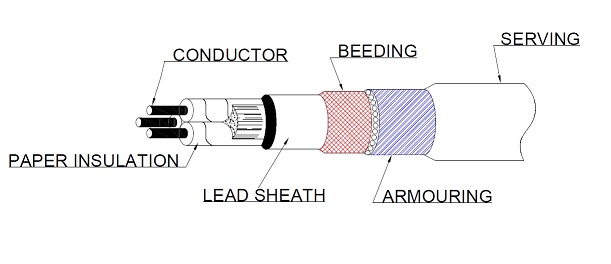An underground cable essentially consists of one or more conductors covered with suitable insulation and surrounded by some protective layer. Normally, electric power can either be transmitted using over head lines or underground cables. But the use underground cable offers a variety of advantages. Some of the advantages are listed below.
- It is less liable to damage during storm or bad whether condition.
- Offers low maintenance cost.
- Less voltage drop during normal operating condition and less chance of fault.
But the main disadvantage of underground cable is its cost of installation. For higher voltage the cost of cable increases due to greater requirement of insulation as compared to overhead lines. Therefore, it is installed in area or localities where overhead lines cannot be installed.
There are various types of cable available but the choice of particular type depends on the operating voltage and service requirement. However, a cable must fulfill some of the basic requirement. Those requirements are as follows:
- The conductor used in underground cable shall be tinned copper or aluminum conductor of high conductivity. Stranding is very important to provide flexibility and increase current carrying capacity.
- The size of conductor shall be sufficient enough to carry load current without heating and appreciable voltage drop. The voltage drop shall be within the permissible range.
- The cable must have proper thickness of insulation to provide high degree of safety and reliability at operating voltage.
- It must have been provided with suitable mechanical protection to withstand rough handling during lying of cable.
- The material used in the manufacture of cable should be such that there is complete chemical and physical stability throughout.
Construction of Underground Cable
An underground cable consists of conductor, insulation, sheath, bedding, Armour and serving. Figure below shows the construction of 3 core cable.
Conductor > Insulation > Metallic Sheath > Bedding > Armour > Serving
Now we will discuss about each part of underground cable in detail.
Cores or Conductors
The number of core or conductors in a cable depends upon its use. For example, a three core cable is used for three phase system. The conductors are made of tinned copper or aluminum and are stranded to provide flexibility.
A suitable thickness of insulation is provided on each core or conductor so that the conductors of underground cable may withstand the operating or designed voltage. The thickness of insulation on the core increases as the operating or design voltage is increased. Normally the insulation materials are made of impregnated paper, varnish cambric or rubber mineral compound.
Metallic sheath surrounds the insulation on the core. It is provided to protect the insulation from moisture, gases, oil, liquids etc. present in the soil and atmosphere. It is normally made of lead or aluminum.
Bedding surrounds the sheath. It is made of fibrous materials like jute or hessian tape. The purpose of bedding is to protect the sheath from mechanical injury due to armouring. You can think it like a shock absorber.
Armouring is provided over the bedding to protect the cable from mechanical injury during its handling and lying. It consists of one or two layers of galvanized steel wire or steel tape. In some cable, armouring is not provided.
To protect the armouring from atmospheric condition, a layer of fibrous material like jute is applied on the armouring. This layer is called serving.
Thus, we observe that the main working part of underground cable are core / conductor and Sheath. Other parts of cable, just protect the conductor and sheath from mechanical injury or chemical attack. This does not mean that, they are not important. Bedding, Armouring and Servings are very important parts of cable else cable won’t work as its insulation will degrade.

I have a singh that says underground cable call before digging what kind of a cable am I dealing with